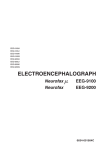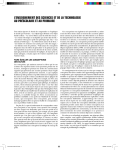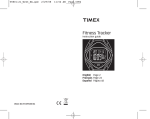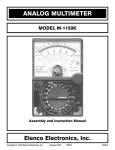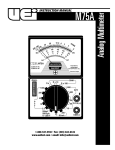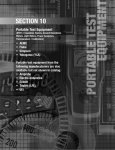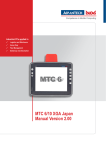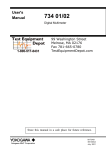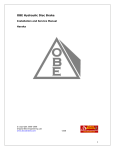Download User`s Manual
Transcript
User's Manual Model 320110 Circuit Tester IM 3201–E 12th Edition Dec. 2007 (KP) Thank you for purchasing this Model 320110 Circuit Tester. To fully exploit and properly operate the instrument, read this manual carefully prior to using the product. Precautions for Safe Use To avoid the risk of injury to personnel including electrical shock or even fatalities, carefully observe and follow the warnings listed below. When operating the instrument, be sure to observe the cautionary notes given below WARNING to ensure correct and safe use of the instrument. Yokogawa is by no means liable for any damage resulting from use of the instrument in contradiction to these cautionary notes. Measurement · This tester is designed for measurement of light electrical circuits. For safe use, do not use this instrument for the circuit exceeding 250 V (including power lines). Such strong electrical circuits may contain a surge voltage, which is several times stronger than that of circuit voltage, thus creating a very dangerous situation. · Do not touch the I/O terminals during the measurement of voltage because a high voltage may be generated on the measurement lead. The following safety symbols are used on the instrument and in this manual: Danger! Handle with Care. This symbol indicates that the operator must refer to an explanation in the User’s Manual in order to avoid risk of injury or death of personnel or damage to the instrument. Measurement lead · Use the lead supplied by Yokogawa for the instrument concerned. · Do not use a deteriorated or damaged lead. · Do not attach/detach the lead to/from the instrument prior to releasing the lead from the measured object. This symbol indicates alternating current (AC). This symbol indicates direct current (DC). This symbol indicates a fuse. Protection · If there are any cracks or other damage in the case because of being dropped or struck, the instrument may not be safely insulated. Do not use the instrument before any remedial measures are taken. This symbol indicates a grounding line. WARNING Indicates a hazard that may result in the loss of life or serious injury of the user unless the described instruction is abided by. CAUTION Indicates a hazard that may result in an injury to the user and/or physical damage to the product or other equipment unless the described instruction is abided by. Battery/Fuse Replacement · Prior to detaching the cover for replacing the battery or fuse, release the measurement lead from the measured object and turn off the switch. Operating Environment · Do not operate the instrument in a flammable or explosive atmosphere. · Do not use the instrument when there is condensation on it. · Do not operate the instrument with wet hands. Disassembly · Disassemblement of the instrument should be conducted only by our service engineers. IM 3201–E — i — To avoid the risk of injury to personnel including electrical shock or damage to the instrument, carefully observe and follow the instructions listed below. CAUTION Measurement · Do not apply a voltage or current over the allowable limits between the terminals. · Do not apply a voltage to the measuring terminals when measuring DC currents (DC mA). Notice Regarding This Instruction Manual 1. The contents of this instruction manual are subject to change without prior notice. 2. All rights are reserved by Yokogawa. No one is allowed to make copies of, reprint any part or all the contents of this instruction manual without permission from Yokogawa. 3. If any questions arise or errors are found, or if any information is missing out from this manual, please inform us. 4. Yokogawa is by no means liable for any damage resulting from the misuse of this product by the user. Power source of measured objects · A voltage may be applied to metals or wires that are connected to electrical equipments. Connect the measuring terminals after confirming that a voltage has not been applied, and the same applied to the grounding systems. Battery · If the instrument is not used for a long period, store it with the battery removed. Otherwise, any leakage from the battery may damage the instrument. CAUTION · To avoid deterioration or damage to the circuit components, keep out of direct sunlight and do not use or store the instrument in locations subject to high temperature and high humidity including inside vehicles. · Both sides of the front cover of the tester have been treated with antistatic coating. Use of a wet cloth for wiping the cover shall be avoided since it degrades the coating. Wipe softly with a dry sheet if the cover gets dirty. Use of volatile solutions such as thinner, benzine, or other chemicals shall also be avoided. · The case and the tester cover are made of thermoplastic resin. Keep the instrument away from any high temperature heat source (e.g. a soldering iron). IM 3201–E — ii — Contents 1. Introduction ...................................................................................1 2. Parts Identification ........................................................................2 3. Operation ......................................................................................5 3.1 Instruction for Use...................................................................5 3.2 DC Current Measurement (DC.mA)........................................6 3.3 DC Voltage Measurement.......................................................6 3.4 AC Voltage Measurement (AC.V) ...........................................6 3.5 Measurement of Low (Audio) Frequency Output Level...........8 3.6 Resistance Measurement .......................................................8 3.7 Checking Battery Amount and Battery Replacement .............9 3.8 Circuit Diagram (Parts List)...................................................10 4. Use of Accessories (Additional Specifications) ..........................11 4.1 Model 320310 12 kV DC High Tension Probe ......................11 4.2 Model 320410 12 A DC Shunt ..............................................12 4.3 Model 320510 Clip-On Current Transformer (Order Discontinued Item).....................................................12 5. Maintenance ...............................................................................13 5.1 Adjustment............................................................................13 5.2 Fuse Replacement ...............................................................13 6. Specifications..............................................................................14 6.1 Specifications .......................................................................14 6.2 Accessory Specifications......................................................15 IM 3201–E — iii — IM 3201–E — iv — 1.Introduction The Model 320110 is a handy and widely usable circuit tester designed with high reliability for the measurements of DC/AC currents, DC/AC voltages, DC resistances, etc. Through these measurements, a variety of electronic and electrical equipment are readily adjusted, tested, or maintained. (7) The instrument requires only one piece of R20P (SUM-1). Battery replacement is easily conducted. (8) Shock-resistance plastic (ABS resin) is used for the case of the tester. It is compact, light, and convenient to carry about. <Features> (1) Employment of taut band suspension for the tester permits high sensitivity, reproducibility of indications, and long duration; yet its mechanism is rugged against vibration or shock, and has no friction. (2) The tester features high input impedance. The internal resistance of the voltage circuit is as high as 100 kΩ/V at DC, or 10 kΩ/V at AC, which is higher than that of any other conventional circuit testers as a tester without amplifier. It can also be used as an electronic voltmeter. (3) Results of the measurement with 320110 are highly accurate, with ±2% for DC or ±3% for AC. The scale has a built-in mirror (105 millimeter in scale length) to eliminate parallax in reading. (4) A solid state overcurrent protective circuit is provided with the tester so as not to burn the coil due to overcurrent, nor bend the pointer arm. (5) The measuring range select switch determines the duration of life of the instrument. It employs a printed wiring switch which has low contact resistance and substantial stability and durability in both mechanical and electrical aspects. (6) A convenient polar ity select switch is provided for DC measurements. — 1 — IM 3201–E 2. Parts Identification 1. Scale 12. Case 2. Knife-edge Pointer 4. Cover Fixing Screw 3. Meter Cover 5. Zero Adjust Screw 7. Zero ohm Adjust Knob 14. Bottom Case Fixing Screw 6. Polarity Select Switch 8. Measuring Range Select Switch 11. OUTPUT Terminal 13. Rubber Leg 9. Common Terminal 10. V.A.Ω Terminal Fig 2.1 Parts Identification 15. Measuring Probe Fig 2.2 Measuring Probe IM 3201–E — 2 — 1. Scale 2. Knife-edge Pointer 3. Meter Cover 4. Cover Fixing Screw 5. Zero Adjust Screw 7. Zero ohm Adjust Knob When measuring resistance, this is to adjust the pointer to zero of the [OHM] scale by shorting the tip ends of the measuring probes of the leads. <Checking batteries> This is also used when checking the remaining amount of built-in battery. (Refer to 3.7 Checking Battery Amount and Battery Replacement) 8. Measuring Range Select Switch This is a switch to select an object to be measured and its measur ing range depending on the purpose of measurement. It consists of a printed wiring switch. The scale has a built-in mirror to avoid parallax in reading. Look at the scale so that you can see the pointer is accurately aligned with the pointer reflected on the mirror, and then read the value. This is made of acrylic resin. This is to set the pointer to zero with a screwdriver if it does not rest at zero prior to measurement. 6. Polarity Select Switch I n t h e c a s e o f D C vo l t a g e o r D C current measurement, the polarity select switch is set to the +DC or -DC position according to the polarity of the measuring circuit. While, in the case of AC voltage or low frequency output level or resistance measurement, it is turned to +DC,AC,Ω . This switch has a 3-contact switch to make deflecting angles of the pointer wider to clarify the polarity selection. <Center Position> When the switch is rested at the center position, the circuit is opened and the pointer coil is shorted, thus, the pointer does not deflect. Set it to this position when carrying the instrument around. — 3 — IM 3201–E 9. Common Terminal This is a common terminal for measurement. The black lead, which is one of accessories, is connected here. The red lead, which is one of accessories, is connected here. This is to measure AC voltage including DC components. The red lead is connected here. This is made of shockresistance plastic (ABS resin). 10. V.A.Ω Terminal 11. OUTPUT Terminal 12. Case 13. Rubber Leg 14. Bottom Case Fixing Screw MS OH 1K 2K ∞ DC.mA 0.012 0.12 DC Current 1.2 12 120 1200 DC.V 0.3 DC Voltage 1.2 3 12 30 120 AC.V 3 AC Voltage 12 30 120 300 1200 Ω ×1 Resistance ×100 ×10 k 300 15 6 10 4 5 0 0 01 5 OH MS 3 20 8 2 10 0 3 12 0 DC AC +1 1 DC.V : 100 kΩ / V AC.V : 10 kΩ / V Fig 2.3 Scale 1200 Measuring Range Select Switch — 4 — 1 25 10 2 0 dB –2 Table 1 Measuring Range IM 3201–E 0 5 DC C A W h e n r e p l a c i n g b a t t e r i e s, remove this screw to open the back cover. This instrument provides two lead wires (i.e. one black and one red). The clip adaptor can be used conveniently by being connected to the tip end of the black lead probe. 15. Measuring Probe 1 00 02 50 00 50 10 20 30 dB Make sure to read and observe all the following cautions before starting measurement to ensure safety. 3. Operation CAUTION 3.1 Instruction for Use 1. Make sure prior to measurement that the pointer rests at the zero position of the scale. If not, turn the zero adjust screw to set it to zero. Look at the scale so that you can see the pointer is accurately aligned with the pointer reflected on the mirror, and then read the value. 2. When the measuring value is unknown, start measurement with the maximum range provided and then continue to lower range until proper range is obtained. Do not select the switch while the pointer is still deflecting. 3. Do not place the tester in strong magnetic fields or on steel plates to avoid possible pointing errors. 4. When storing or carrying the tester, turn off the measuring range select switch and set the polarity select switch to its center position to avoid any possible damage. Checking Fuse Make sure prior to measurement that the fuse is not burned out. <Checking Method> Set the measuring range select switch to “Ω” range. The fuse operates normally if the pointer points at zero Ω when shorting the V.A.Ω terminal. The pointer does not deflect when the fuse is burned out. At the start of measurement, always be sure to check it. Never use the instrument when the fuse is burned out to avoid electrification. It happens when the instrument falsely recognizes voltage-applied measured objects as being inactive. Checking Measurement Range ·Make sure that the measuring range select switch is set properly and that the measurement lead and the measurement (input) terminal are connected appropriately. Measuring high voltages erroneously while the range is in “DC mA” may cause personnel injury or damage to the instrument. ·Prior to turning on/off the measuring range select switch, disconnect the measurement lead from the measured object. Installation Location Be sure to place the instrument on a flat stable surface in a stable environment. The measurement lead may get disconnected from the measurement ter minals due to over tur n or fall of the instrument. If it happens, there is a possibility of electrical shock especially when a high voltage is measured. — 5 — IM 3201–E 3.2 DC Current Measurement (DC.mA) 3.4 AC Voltage Measurement (AC.V) 1. Connect the red lead to the V.A.Ω terminal and the black lead to the COM- terminal. 2. Set the polarity select switch to the +DC,AC,Ω position. 3. Set the measuring range select switch to a desired position on the “AC V” range. Then, read out the indication on the [AC] scale. 4. This voltmeter of the tester is a rectifier type meter in which germanium diodes are incorporated with the moving coil type meter, and the scale is calibrated in term of RMS value of pure sine wave alternating current. For this reason, note that application of nonsinusoidal AC will cause errors in indication. CAUTION There is a risk of damaging the instrument. If a voltage is erroneously applied while the range is in “DC mA”, the shunt resistor of the tester will be burned out. 1. Connect the red lead to the V.A.Ω terminal and the black lead to the COM- terminal. 2. Set the polarity select switch to the +DC,AC,Ω position. 3. Set the measuring range select switch to a desired position on the “DC mA” range. Check polarity and connect the tip end of the lead probes in series to the circuit to be measured. Then, read out the indication on the [DC] scale. 4. If the pointer deflects inversely, change over the polarity select switch to the -DC side. Thus, current can be measured without changing the lead connections. 3.3 DC Voltage Measurement 1. Leads connections and the polarity select switch positioning are the same as in the case of the DC current measurement described above. 2. Set the measuring range select switch to a desired position on the “DC V” range. Check polarity and connect the tip end of the lead probes in parallel to the circuit to be measured. Then, read out the indication on the [DC] scale. 3. If the pointer deflects inversely, change over the polarity select switch to the -DC side. IM 3201–E — 6 — 5. When it is desired to measure a voltage of high frequency, connect the COM- terminal to the ground side of the measuring circuit. This arrangement prevents indication errors caused by the stray capacitance between the tester and the ground. (Refer to Fig 3.1 Frequency Characteristics in which an example of the frequency characteristics is shown.) 6. When measuring AC voltage in the circuit where a DC component is included, connect the leads respectively to the OUTPUT terminal and COM- terminal. For further procedures, follow instructions described in the paragraph “AC Voltage Measurement”. 7. To the OUTPUT terminal a 0.2 µF capacitor (400 W. V) is internally provided in series so that the DC component is impeded and only the AC voltage is indicated. 8. In case of low frequency, voltage drop across the capacitor causes an error in indication. This error depends upon the measuring range. (Refer to Fig. 3.2 Frequency Characteristics when OUTPUT Terminal is Used) Error 5 120 V Range 4 30 V Range (%) 3 2 1 12 V 0 0.2 0.5 1 2 5 10 20 ge e an ng Ra 3 V R 50 100 Frequency (kHz) Fig 3.1 Frequency Characteristics Frequency (Hz) 20 0 50 100 200 500 1000 Error 30 V Range (%) -10 12 V Range -20 -30 3 V Range -40 Fig. 3.2 Frequency Characteristics when OUTPUT Terminal is Used — 7 — IM 3201–E 3.5 Measurement of Low (Audio) Frequency Output Level 1. The output level denotes the voltage in the audio frequency range, being applied to a specific load impedance. This output voltage is expressed in dB. 2. This instrument is calibrated for a 0 dB reference level when 1 mW of power is developed in a 600 Ω load (0.775 AC V into 600 Ω). 3. Measuring procedures are as described in the paragraph “AC Voltage Measurement”. The indication is read out on the [dB] scale. 4. The dB values on the scale are the ones when the measure range select switch is set to the “AC 3 V” range. Add dB value read from value indicated on dB chart (shown below right) on the scale panel. 1. Connect the two measuring lead probes respectively to the V.A.Ω and COM- terminals. 2. Set the polarity select switch to the +DC,AC,Ω position. 3. Set the measuring range select switch to a desired position on the “Ω” range. Short the tip ends of the two measuring probes of the leads. Turn the zero ohm adjust knob ΩADJ and set the pointer to zero of the [OHM] scale. Note: This zero adjustment must be repeated each time when the measuring range is changed over to another. 4. Connect the tip ends of the measuring probes respectively to the points across which the resistance is to be measured. Take the reading on the [OHM] scale, and multiply the value read by the multiplying factor of the applying measuring range. Thus, the resistance value is obtained. 0 dB: 1 mW 600 Ω AC.V RANGE ADD dB 3 12 30 120 0 12 20 32 3.6 Resistance Measurement CAUTION There is a risk of electrification or damaging the instrument. ·Prior to measuring the resistance in the circuit of equipment, the power source to the equipment must be disconnected. ·For the measurement of a circuit which includes capacitors, the charged electricity must be discharged from the capacitor. Note that the external voltage may burn the resistors of the tester. IM 3201–E — 8 — 3.7 Checking Battery Amount and Battery Replacement 5. Current for each measuring range is as follows, at zero position of resistance scale. × 1 Ω range approximately 150 mA × 100 Ω range approximately 1.5 mA × 10 kΩ range approximately 15 µA 6. For checking quality of capacitors, use the × 10 kΩ range. A good capacitor is charged by the battery voltage of the tester, to cause a deflection of the pointer. The pointer is then returned gradually to the “∞” position. This phenomenon appears more markedly as greater the capacity of a capacitor becomes. Degraded capacitors will not deflect the pointer. And shorted capacitors will not return the pointer in the “∞” direction. These are defective capacitors. 7. In case of resistance measurement, polarity of the self-contained battery is positive at the COM- terminal, and negative at the V.A.Ω terminal. Take this relation into consideration when diodes or transistors are to be tested. <Checking the Remaining Amount of Battery> The condition where the pointer does not come to zero even when the zero ohm adjust knob is turned clockwise to the extreme position is to indicate that the built-in battery is worn out. Replace the battery (R20P, 1.5 V, one piece). <Battery Replacement> CAUTION · Before starting the replacement of the battery, disconnect the instrument from the circuit to be measured to prevent an electrical shock hazard. · Check polarity before installing the battery properly. To replace the battery, remove the screw of the center of the bottom case. For battery installation, follow the indication of polarity noted on the battery holder case. — 9 — IM 3201–E 3.8 Circuit Diagram (Parts List) Parts List Circuit DC mA DC V Ω AC V R1 R2 R3 R4 R5 R6 R7 R8 R9 R10 R11 R12 R13 R14 R15 R16 R17 R18 R19 R20 R21 R22 R23 R24 R25 R26 R27 R28 R29 R30 VR1 VR2 VR3 M D1 D2 D3 D4 D5 D6 C1 C2 F E SW1 SW2 PTH 1200 120 12 1.2 .12 .012 .3 1.2 3 12 30 120 300 1200 1200 300 120 30 12 3 × 1 × 100 × 10 kOFF A.V.Ω E R29 C1 OUTPUT R2 R3 R4 R5 R1 COM(–) R8 R9 R10 R11 R12 R13 R14 R7 F (2A S-M1301 #20) R15 R16 R17 R18 R19 R20 D4 D6 D3 SW1 R21 M SW2 R28 R25 R26 R24 ACΩ –DC + DC VR1 C2 D5 R27 R22 D2 VR2 R23 PTH VR3 D1 R30 Fig 3.3 Circuit Diagram IM 3201–E — 10 — Parts Wire wound resistor 0.19 Ω Wire wound resistor 1.8 Ω RD1PX 18 ΩF RD1/2PX 180 ΩF RD1/2PX 1.8 kΩF RD1/4PX 110 kΩF RD1/4PX 8 kΩF RD1/4PX 90 kΩF RD1/4PX 180 kΩF RD1/4PX 900 kΩF RG08V2K 1.8 MΩF RG08V3C 9 MΩF RG08V3C 18 MΩF RG08V3C 90 MΩF RG08V3C 9 MΩF RG08V3C 1.8 MΩF RD1/2PX 900 kΩF RD1/4PX 180 kΩF RD1/4PX 90 kΩF RD1/4PX 11.3 kΩF RD1/4PX 10 kΩF RD1/4PX 10 kΩF RD1/4PX 50 kΩF Wire wound resistor 8Ω 1 RD /4PX 792 ΩF RD1/4PX 79.2 kΩF RD1/4PX 203 ΩF RD1/4PX 73.3 kΩF RD1/2PX 1.45 ΩF RD1/4PX 27 kΩF Semifixed resistor approx. 10 kΩ Semifixed resistor approx. 10 kΩ Semifixed resistor 40 kΩ Indicator 10 µA (9 kΩ) Germanium diode Germanium diode Silicon diode (1GZ61) Silicon diode (1GZ61) Silicon diode (1GZ61) Silicon diode (1GZ61) Film capacitor 0.22 µF; 400 V Film capacitor 0.68 µF; 200 V S-M1301 #20 (2 A) Dry Cell SUM-1 1.5 V Measuring Range Select Switch Polarity Select Switch Positive temperature coefficient resistor 602M 1. This probe is intended to be used in the adjustment of high voltage electronic equipments such as television. However, the high voltage measurement on power lines is dangerous, and must be avoided. 2. Firmly connect the Protective Resistance Box of the high voltage probe to the terminal of the tester so that the probe may come to the V.A.Ω terminal side of the tester (and the clip adapter to the COM- terminal side). 3. Set the polarity select switch to +DC,AC,Ω and the measuring range select switch to the “DC 1.2 V” range. Then, read the value on the [DC] scale. 4. Use of Accessories (Additional Specifications) 4.1 Model 320310 12 kV DC High Tension Probe Tester terminals COM- V.A. Ω Fig 4.1 12 kV DC High Tension Probe CAUTION When measuring high voltage, observe the following safety precautions to avoid potential risks. · Make sure that the grounded leads are firmly connected. · Check the probes (must not be wet or contaminated with foreign materials) prior to measurement to avoid possible risks. Wear a pair of gloves (e.g. rubber gloves) to ensure safety. · Avoid measuring high voltage on the power line to prevent possible hazards. — 11 — IM 3201–E 4.2 Model 320410 12A DC Shunt 4.3 Model 320510 Clip-On Current Transformer (Order Discontinued Item) red Fig 4.2 12A DC Shunt 1. This shut is best suited for the current measurement in power transistors or SCR circuits. 2. Connect the banana plug of the “+” terminal of the shunt to the V.A.Ω terminal of the tester, and the banana plug of the “-” terminal to the COM- terminal. 3. Set the polarity select switch to +DC,AC,Ω and the measuring range select switch to the “DC 0.012 mA” range (voltage drop 220 mV). Then, read out the indication on the [DC] scale. black Fig 4.3 Clip-On Current Transformer 1. By use of this transformer, currents to the commercial frequencies can be measured without opening the circuit. 2. Connect the red lead of the transformer to the V.A.Ω terminal and the black lead to the COM- terminal. 3. Set the polarity select switch to +DC,AC,Ω and the measuring range select switch to the “AC 3 V” range. Then, read out the indication on the [AC] scale. 4. The transformer provides 5 ranges of current; 12/30/60/120/300 A. These ranges can be selected by the selector switch attached to the transformer. Read out the indication on the [AC] scale based on full scale values appropriate to the selected range. IM 3201–E — 12 — 5.2 Fuse Replacement 5. Maintenance CAUTION There is a risk of electrical shock to persons. ·Prior to replacing the fuse, disconnect the instrument from the circuit to be measured, if connected, to prevent an electrical shock hazard. ·Do not operate the instrument when the case is left open. ·Use only the specified fuse. 5.1 Adjustment In case of the accuracy of the tester becomes doubtful as the result that an excessive load of shock is applied to the tester, the tester must be tested using other calibrated instrument. If the accuracy is observed to be over the specified value, the tester must be readjusted. In case the resistor is burnt, it must be replaced according to the circuit diagram and parts list (in Section 3.8), and further, the sensitivity of the tester must be adjusted in the following manner. (1) Set the polarity select switch to +DC,AC,Ω and the measuring range select switch to the “DC 0.3 V” range. Apply “DC 0.3 V” and turn the semifixed resistor VR 1 (as indicated on the print board) so that the pointer may indicate the full scale value correctly. (2) Set the measuring range select switch to the “AC 120 V” range. Apply “AC 120 V” and turn the semifixed resistor VR2 so that the pointer may indicate the full scale value correctly. Above procedures make a complete adjustment on the DC, AC, and Ωcircuits. In case the fuse has blown, remove the screw of the center of the bottom case. Then, replace the blown fuse with a new one (of specified rating) that is provided on the side surface of the case. After Services When the instrument does not operate properly and needs repair, please contact Yokogawa or the store where you bought the product. — 13 — IM 3201–E 6. Specifications 6.1 Specifications Measurement Measuring Range Accuracy Remarks Voltage 0.3/1.2/3/12/30/120/300/1,200 V (*1) ±2% of full scale value Current 0.012/0.12/1.2/12/120/1,200 mA ±2% of full scale value Terminal Voltage Drop: Less than 250 mV AC Voltage 3/12/30/120/300/1,200 V (*1) ±3% of full scale value Input Impedance: 10 kΩ/V Resistance 2/200/20,000 kΩ ±3% of scale length (*3) Central Scale Mark: 10 Ω (for full scale value of 2 kΩ) DC Low Frequency Level -20 to 11/23/31/43 dB (*2) *1: *2: *3: ±3% of full scale value Input Resistance: 100 kΩ/V Input Impedance: 10 kΩ/V Accuracy in 1200 V range is ±3% for DC or ±4% for AC. The tolerance for the low frequency output has been expressed as a percentage of the value obtained by converting the maximum scale value (dB) to a voltage. The scale length of resistance measurement (OHM) is 110 millimeters. Insulation Resistance: Withstand Voltage: Battery: Dimensions: Weight: Accessories: IM 3201–E DC 500 V, 100 MΩ Between the electric circuits and case - up to AC 50 Hz/3,400 V for 1 minute R20P (SUM-1), 1 pc. Approx. 190 × 124 × 71 mm Approx. 870 g The following items are supplied with each instrument at no extra cost. Leadwires with probe and plug RD031…1 pair Dry Cell JIS C 8501 Types SUM-1 (1.5 V) (built-in)…1 pc. Clip Adapter…1 pc. Carrying Case…1 pc. User's Manual 1 copy — 14 — 6.2 Accessory Specifications Model 320310 12 kV DC High Tension Probe Rating Voltage: DC 12 kV Accuracy: ±5% of rating (when connected to the tester 320110) Current Loss: approximately 20 µA Allowable Input Voltage: DC 15 kV Model 320410 12A DC Shunt Rating Current: Rated Voltage Drop: Accuracy: DC 12 A 220 mV ±3% of rating (when connected to the tester 320110) Model 320510 Clip-On Current Transformer (Order Discontinued Item) Rating Current: AC 12/30/60/120/300 A AC Accuracy: ±3% of rating (when connected to the tester 320110) Frequency Characteristics: less than ±1% of indication value at 50 and 60 Hz — 15 — IM 3201–E <MEMO> IM 3201–E — 16 — ����������������������������������������� ������������������������� ���������������������������������������������������������������������� ������������������������������������������������ ���������������������������������������� ������������������������������������������������ ��������������������������������������� ������������������������������������������������ ����������������������������������������������� �������������������������������������������� �������������������������������������� �������������������������������������������������� �������������������������������������������������������� ������������������������������������������������������� ���������������������������������������� ������������������������������������������������ ��������������������������� �������������������������������������������������� ������������������������������������������� �������������������������������������������������� ������������������������������������ ���������������������������������������� ������������������������������������������� ������������������������������������������������ �����������
























